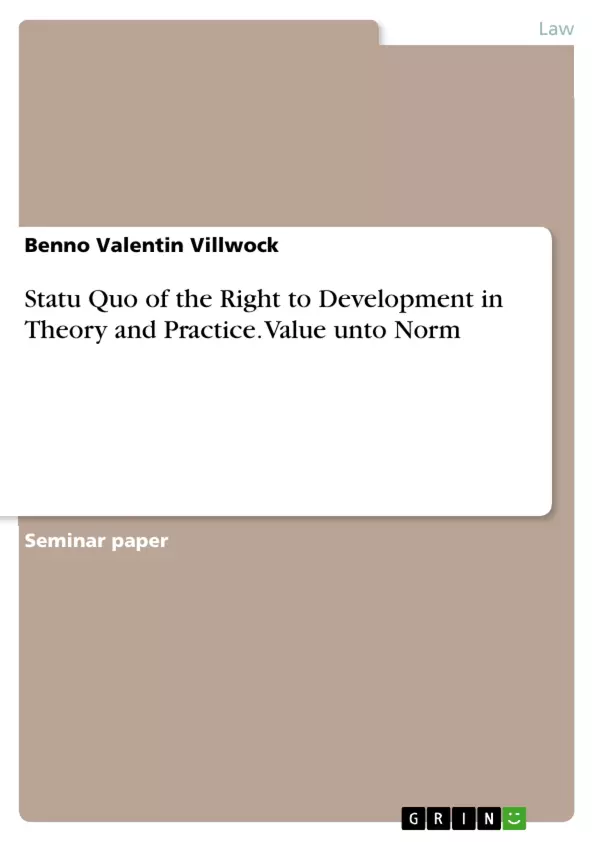This paper offers an evaluation of the legal status of the right to development (RTD). It looks at its material content, practical implementation as well as theoretical basis of validity.
(1) The RTD constitutes an ideal of balanced, purposeful development whose material essence can be summarized as follows:
The right to development is a human right by virtue of which every human person and all peoples are entitled to participate in and to enjoy economic, social, cultural and political
development. Development is an empowering process in which all human rights and fundamental freedoms have to be respected and can be fully realized. States have the primary
responsibility for the creation of national and international conditions favorable to the realization of the right to development and the duty to co-operate with each other to this end.
(2) The RTD is hence a fusion of a broad set of single values, transmuted into the complex vision of a common, human rights based development standard concerning both process and result. Taking for granted the idea of inalienable human dignity, the moral value of the RTD, concerning the essential connection of human rights and development, seems beyond question.
(3) The DRD translates a moral value into a legal norm. First and foremost the RTD claims the realization of an overall empowering societal progress as an inalienable privilege for all human beings and demands the solidary assistance of all relevant actors to this end.
Inhaltsverzeichnis (Table of Contents)
- I. The Right to Development in Theory.
- A. Evolution of a Legal Norm concerning a Right to Development
- B. The Substance of the Right to Development
- 1. Localization of the RtoD within the body of human rights law
- 2. Addressees and subject-matter of the Right to Development
- a) Beneficiaries and entitlements
- b) Duty holders and obligations
- 3. Value added by the Right to Development
- C. Theoretical Legal Value of the Right to Development
- 1. An compilation of controversies
- 2. Grounds of Validity, potential formal sources
- 3. First assessment on the legal value of the RTD
- II. The Right to Development in Practice
- A. Means and Strategies of the Operationalization
- 1. Transnational cooperation within the UN-framework
- a) Promotion...
- b) Implementation
- c) Monitoring and justiciability.
- 2. Implementation on the domestic level:
- 3. Implementation by non-Governmental actors:
- 1. Transnational cooperation within the UN-framework
- B. Obstacles to the Implementation of the Right to Development
- 1. Inherent substantial obstacles to the realization of the RTD.
- 2. International Obstacles to the realization of the RTD.
- 3. Domestic Obstacles to the realization of the RTD
- C. Operational Success, Consolidating Assessment of the Legal Value
- A. Means and Strategies of the Operationalization
- III. Conclusionary Remarks, the RTD in Theory and Practice.
Zielsetzung und Themenschwerpunkte (Objectives and Key Themes)
This work provides a comprehensive analysis of the Right to Development (RTD), tracing its evolution as a legal norm, examining its theoretical and practical implications, and highlighting key challenges to its implementation. It aims to understand the RTD within the broader framework of international human rights law and its contribution to the pursuit of a just and equitable world order.
- Evolution and theoretical grounding of the RTD
- Substance and value added by the RTD
- Mechanisms and strategies for the operationalization of the RTD
- Obstacles to the implementation of the RTD at national and international levels
- Assessment of the legal value and operational success of the RTD
Zusammenfassung der Kapitel (Chapter Summaries)
- I. The Right to Development in Theory:
- A. Evolution of a Legal Norm concerning a Right to Development: This chapter retraces the historical development of the RTD, starting from classical international law and its evolution within the UN framework. It highlights key international instruments, such as the UN Charter, the Universal Declaration of Human Rights, and the International Covenant on Economic, Social and Cultural Rights, which lay the foundation for the RTD.
- B. The Substance of the Right to Development: This chapter delves into the core elements of the RTD, defining its beneficiaries, duty holders, and the obligations involved. It examines how the RTD contributes to the realization of other human rights and the promotion of sustainable development.
- C. Theoretical Legal Value of the Right to Development: This chapter critically analyzes the legal value of the RTD, exploring controversies surrounding its status, identifying potential formal sources of validity, and providing a preliminary assessment of its legal standing.
- II. The Right to Development in Practice:
- A. Means and Strategies of the Operationalization: This chapter investigates the various means and strategies employed for operationalizing the RTD, including transnational cooperation within the UN framework, domestic implementation measures, and the role of non-governmental actors.
- B. Obstacles to the Implementation of the Right to Development: This chapter examines the significant challenges hindering the realization of the RTD, including inherent obstacles, international hurdles, and domestic barriers.
- C. Operational Success, Consolidating Assessment of the Legal Value: This chapter concludes with an assessment of the operational success of the RTD and its impact on development practices. It explores how the RTD has contributed to promoting development and addressing inequities, while also acknowledging the ongoing challenges and areas for improvement.
Schlüsselwörter (Keywords)
This work focuses on the Right to Development (RTD), international human rights law, sustainable development, international cooperation, transnational cooperation, domestic implementation, obstacles to development, legal value, operationalization, and assessment.
- Citar trabajo
- Benno Valentin Villwock (Autor), 2014, Statu Quo of the Right to Development in Theory and Practice. Value unto Norm, Múnich, GRIN Verlag, https://www.grin.com/document/312221



